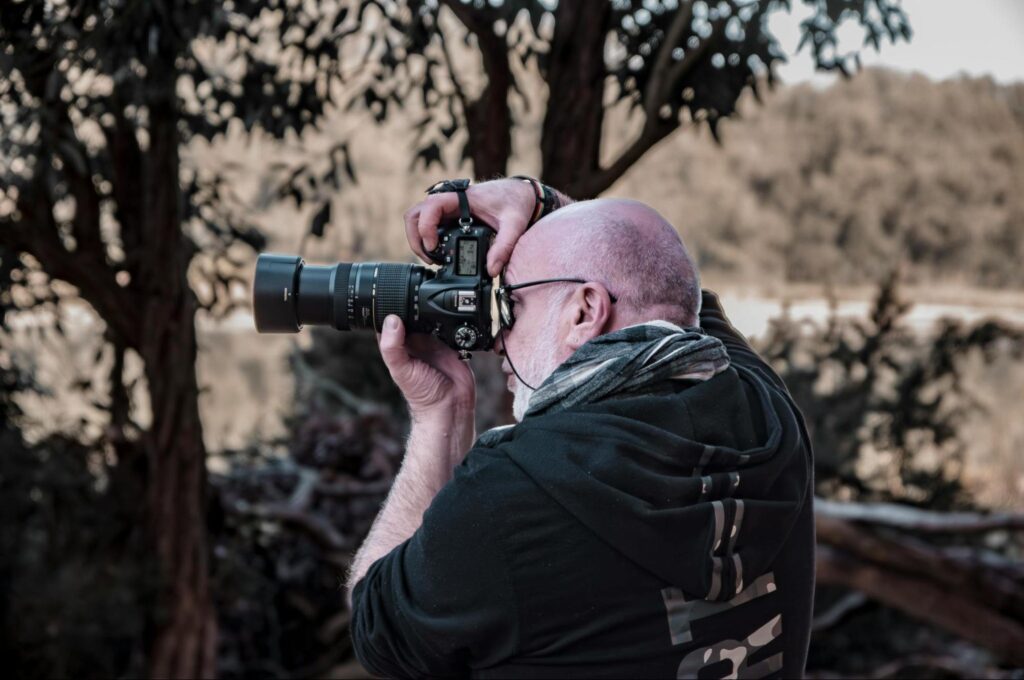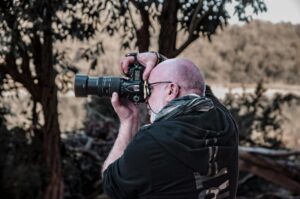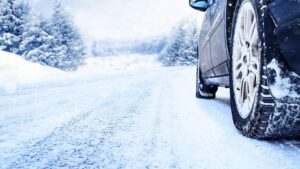Title.
Professional Wildlife Photographers Equipment.
Description.
Professional Wildlife Photographers Equipment. This section covers fundamental equipment, its brief description, purpose, and features of choice. It also includes additional equipment professional photographers use and recommendations for choosing various equipment.
Most professional photographers specialize in a particular area. Some are experts in shooting sports events, others prefer to take unique photo portraits, and others prefer photographing wildlife. Those in the latter category have unique equipment, often including many unusual items. Our article will explain what equipment wildlife photographers use and how they achieve perfect-quality photos.
Cuprins
Essential Wildlife Photographer’s Equipment
Every photographer has his equipment, which usually includes several standard devices and accessories useful in all situations. These form the basic set of equipment necessary for every photographer specializing in wildlife.
Camera
The primary device of any photographer is, of course, a camera. It is chosen depending on many factors, including personal preferences and needs of the user. For photographers who shoot wildlife, cameras with specific characteristics are needed. Most often, models with high resolution and the highest possible shooting speed are in demand. With such parameters, you can photograph anything, including birds, animals, plants, landscapes, and any natural objects (for example, waterfalls, streams, mountains, etc.).
Lentile
A wildlife photographer often cannot get by with a standard lens. He needs several such optical devices simultaneously, each sound in a particular situation. First of all, nature lovers need to have a wide-angle lens. It will be indispensable when photographing landscapes or any large objects. No less helpful in nature will be a long-focus or so-called telephoto lens. It will allow you to shoot various objects long distances and get good-quality photos. This option will be optimal when shooting wild animals that are impossible to approach (for example, dangerous predators or timid mammals). In cases where you plan to shoot the most minor representatives of flora and fauna, you will need a macro lens. It will make it possible to capture everything that, due to its small size, often escapes our gaze.
Filters
Wildlife photographers often use various filters. There are many types, but in this case, you should choose only two. The first mandatory filter is the ultraviolet filter. It will eliminate the influence of atmospheric haze, dust particles, water droplets in the air, and many other things that can significantly worsen the quality of the pictures. It is advisable to use it for shooting objects on the water, high in the mountains or far from your location. The second filter that all wildlife photographers use is the polarizing filter. It helps get rid of glare on water, snow and other surfaces. Thanks to its use, the pictures will be higher quality and more transparent. The polarizing filter is ideal for shooting various living creatures near objects that reflect sunlight.
Flash and Diffuser
Almost all wildlife photographers do not like to use a flash. It scares away animals and makes the objects they photograph look less natural. However, sometimes, you cannot do without a flash. This happens when there is a lack of natural light caused by the object’s location in the shade of plants or rocks, the appearance of clouds in the sky, or a simple change in the time of day.
In all these cases, a flash will make it possible to compensate for the lack of light and improve the visibility of a plant, animal, or object. This device is also necessary for macro photography. It will illuminate the object more efficiently and allow you to capture it in all its glory. Most professional photographers use diffusers in combination with a flash. They help achieve a more even distribution of light, eliminating contrasting shadows and other unnecessary effects.
Tripod
Every professional photographer needs a tripod. Those who love to photograph wildlife should choose the lightest products that will be comfortable to carry around all day. This accessory should also be as durable as possible so that the photographer’s accidental careless movement does not break it. The best models for wildlife are carbon fiber. They are both durable and lightweight, ideal for professionals with this specialization. Sometimes, a standard tripod is supplemented with several mini versions of this accessory. They will not take up much space in the backpack and will not weigh it down too much, but they will significantly simplify the process of macro photography.
Spare accessories
Wildlife photographers always add spare accessories to their essential gear. They will allow them to shoot for more extended periods and avoid the need to return to camp or another temporary location frequently. A key additional accessory is a spare battery. Depending on its capacity and the camera’s ability to use the charge economically, one expedition may require as many as two or even 3-4 items. All of them must be identical and suitable for use on a particular camera. A spare memory card is also an essential additional accessory. It will help out in cases where the main one breaks down or is full of photos.
Additional Wildlife Photographer’s Equipment
In addition to the essential equipment, all photographers use dozens of additional items, devices and gadgets. These valuable additions allow photographers to perform various tasks and expand their shooting capabilities. They also help photographers cope with many standard functions that arise while outdoors.
Thermal Imaging Device
To be successful in wildlife photography, you need to be able to find various animals in dense vegetation. Most professionals use a thermal vision monocular and similar optics for this. It allows you to receive a thermal image of the inspected area on display and detect the presence of even well-camouflaged, warm-blooded living creatures. The presence of such devices speeds up the search process and gives more chances to create a genuinely high-quality photo. Also, many photographers use thermal imaging optics to improve their safety. With it, you can promptly notice dangerous predators and take the necessary measures to avoid contact with them.
Night Vision Device
Night vision devices will always be helpful additional equipment for any professional specializing in wildlife photography. They will become indispensable assistants in the twilight. Even after the sun has completely set, they can provide the user with a clear and detailed image of the surrounding area. The ability to see well in the dark allows photographers to detect various living creatures that lead a nocturnal lifestyle. Their photos are always the most valuable, so everyone will have a chance to be successful. Various night optics will also allow you to safely move around unknown natural locations, notice potential dangers, find a pre-selected path, adjust the camera and much more.
A Suitable Backpack
An important additional piece of equipment for a photographer is a backpack. It is selected depending on many factors and is used to place everything needed for shooting nature. Most often, professionals take several cameras, lenses, and many other devices and equipment. All of them should fit freely in the backpack next to other valuable items. In cases where shooting is planned in different countries, the backpack is selected depending on the maximum permissible dimensions of hand luggage on the plane. In other situations, this product is chosen so that the photographer can place all his things and not experience excessive discomfort during their long-term wear on his back.
Medicines
The list of valuable additions cannot fail to include various medications. They are necessary not only for photographers but also for lovers of other outdoor activities. The list of drugs is selected depending on the needs of the person and can include quite a lot of drugs. Photographers also take special medicines that will help avoid various diseases typical for the region where the event is planned. A first aid kit supplements the selected set of medications.
It will be helpful in cases where the photographer or people accompanying him receive some injury. Its presence will make it possible to avoid more serious consequences and continue shooting wildlife.
Protective Equipment
When photographing wildlife, photographers never forget about their safety. That is why they always carry a variety of protective equipment. Their number is selected depending on the characteristics of the territory where the shooting will take place. Most often, the backpacks of wildlife photographers contain means of protection against harmful insects. They allow you to avoid thousands of bites and their associated troubles (for example, an allergic reaction). Photographers also often take various devices and objects that can scare off predators or protect themselves from their attacks. A weapon may be needed in some of the world’s most dangerous countries. Most often, it will not be used for its intended purpose but to intimidate anyone who wants to steal something from the backpack or harm the photographer himself.
Hiking kit
A wildlife photographer will often differ from a hiking enthusiast by having better photographic equipment. In all other respects, these two activities are very similar. While searching for good shots, people with cameras walk long distances, enjoy the beauty of nature, make stops, spend the night in the open air, and much more. Due to such similarities between both activities, photographers always take a specialized hiking kit. It can include dozens of items and devices, each advantageous in a particular situation. Very often, photographers use standard items such as a knife, flashlight, rope, etc., and more exotic accessories. This gives them greater confidence and increases their chances of successfully implementing their ideas.
Photographers specializing in wildlife photography have unique skills and abilities to find interesting shots even where none exist. They use unique equipment in their work that helps them cope with various tasks and succeed in their primary business. Each item, device, and accessory is used for specific purposes; without them, even a professional would not be able to do his job well.






